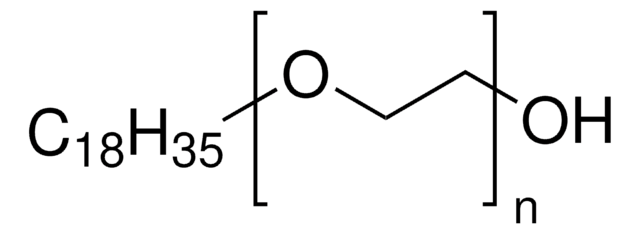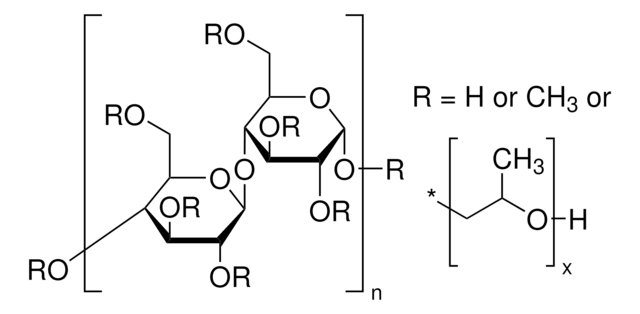STS0213
ECO BRIJ® O10
Synonyme(s) :
Brij® O10, Brij 97, C18-1E10, Polyoxyethylene (10) oleyl ether
About This Item
Produits recommandés
Description
non-ionic
Niveau de qualité
Forme
semisolid
Poids mol.
~709 g/mol
Caractéristiques du produit alternatif plus écologique
Use of Renewable Feedstocks
Design for Degradation
Learn more about the Principles of Green Chemistry.
sustainability
Greener Alternative Product
Impuretés
≤3.0% water
Pf
25 °F
Indice d'acide
≤1.0 mg KOH/g
Indice d'hydroxyle
75‑95 mg KOH/g
Solubilité
water: 100 mg/mL, clear, colorless to faintly yellow
Densité
1 g/mL at 25 °C (lit.)
HLB
12.4
Autre catégorie plus écologique
, Aligned
Chaîne SMILES
O(CCO)CCCCCCCC\C=C/CCCCCCCC
InChI
1S/C20H40O2/c1-2-3-4-5-6-7-8-9-10-11-12-13-14-15-16-17-19-22-20-18-21/h9-10,21H,2-8,11-20H2,1H3/b10-9-
Clé InChI
KWVPFECTOKLOBL-KTKRTIGZSA-N
Vous recherchez des produits similaires ? Visite Guide de comparaison des produits
Description générale
Application
Caractéristiques et avantages
- 100 % Renewable
- 100 % Bio-based
- Certified to the USDA BioPreferred Program
- Lower carbon footprint than petrochemical-based versions
- High-purity chemical suitable for a wide variety of research applications
Propriétés physiques
Autres remarques
Informations légales
Mention d'avertissement
Warning
Mentions de danger
Conseils de prudence
Classification des risques
Aquatic Chronic 2 - Skin Irrit. 2
Code de la classe de stockage
11 - Combustible Solids
Classe de danger pour l'eau (WGK)
WGK 1
Point d'éclair (°F)
>464.0 °F - Equilibrium method
Point d'éclair (°C)
> 240 °C - Equilibrium method
Faites votre choix parmi les versions les plus récentes :
Certificats d'analyse (COA)
It looks like we've run into a problem, but you can still download Certificates of Analysis from our Documents section.
Si vous avez besoin d'assistance, veuillez contacter Service Clients
Déjà en possession de ce produit ?
Retrouvez la documentation relative aux produits que vous avez récemment achetés dans la Bibliothèque de documents.
Contenu apparenté
Our expanding portfolio of greener laboratory chemicals, programs and services support your sustainable chemistry lab work with less hazardous chemicals, biodegradable reagents and greener alternatives to help reduce waste and the environmental impact of chemistry.
Le développement de notre offre de produits, programmes et services de laboratoire plus écologiques permet d'accompagner vos laboratoires de chimie dans leur démarche durable, avec des produits chimiques moins dangereux, des réactifs biodégradables et des alternatives plus écologiques, contribuant à réduire les déchets et l'impact de la chimie sur l'environnement.
Our expanding portfolio of greener laboratory chemicals, programs and services support your sustainable chemistry lab work with less hazardous chemicals, biodegradable reagents and greener alternatives to help reduce waste and the environmental impact of chemistry.
Notre équipe de scientifiques dispose d'une expérience dans tous les secteurs de la recherche, notamment en sciences de la vie, science des matériaux, synthèse chimique, chromatographie, analyse et dans de nombreux autres domaines..
Contacter notre Service technique






